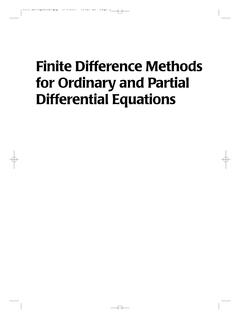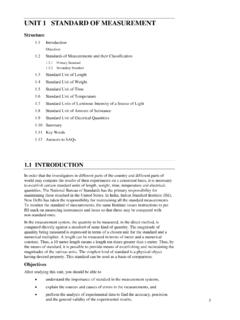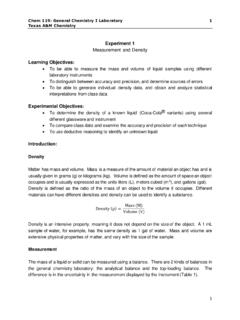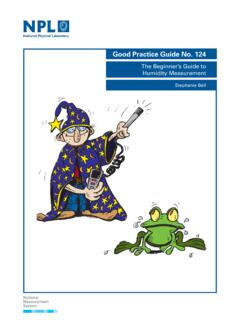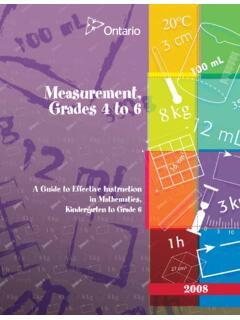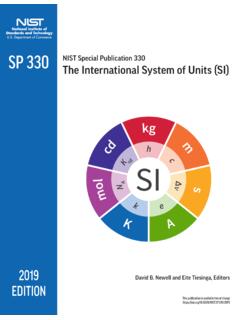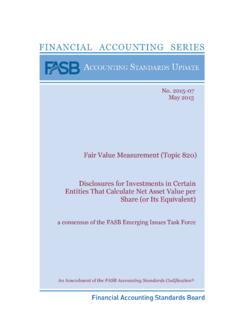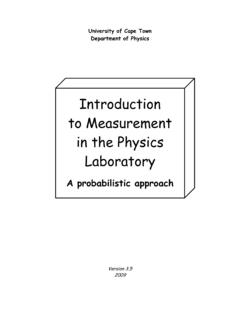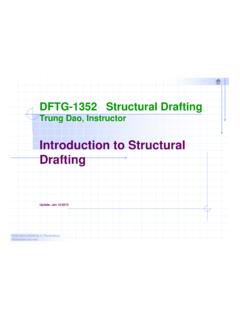Transcription of TEMPERATURE MEASUREMENT LABORATORY
1 1 TEMPERATURE MEASUREMENT LABORATORY 1. Materials needed: ASTM Hg thermometer Regular Hg or alcohol thermometer (keep the same one for the entire temp lab) Davis weather station TEMPERATURE probe Thermocouple, bead thermistor, or platinum resistance thermometer Dewar Wind tunnel Stopwatch Ice Electric kettle Water Paper towels 2. Objectives The objectives of this lab are to familiarize you with some of the various types of TEMPERATURE sensors in current use, to calibrate them (and hence to recognize the relationship between data quality and instrument calibration), and to evaluate the impact of ventilation and time response on TEMPERATURE MEASUREMENT . In this lab, you will also calibrate the Davis TEMPERATURE sensor for your weather station. 3. Tasks Calibrations Calibrate the regular Hg thermometers against the ASTM Hg thermometers (ASTM stands for American Society for Testing and Materials , which is the non-profit organization that writes standards for materials and measurements.)
2 RECORD THE ASTM CALIBRATION CERTIFICATE INFORMATION, you will need this to calculate a total uncertainty in the true value of TEMPERATURE relative to what the NIST MEASUREMENT would be. Establish five different temperatures of water in a dewar, spanning from 0 to LESS than 30C. NOTE THE ASTM THERMOMETERS CAN T EXCEED 30C. To do this, start with ice water as your lowest TEMPERATURE . Then add small amounts of hot water (from the electric kettle) to create four higher temperatures . Use the T indicated on the ASTM as the true T, and note the T indicated by the regular thermometer for each of the five different temperatures . Note, the 5 temperatures used for calibration need not be the same for each sensor type, but the range should be similar. Again, use water at five different temperatures from freezing to 30 C in a dewar, and your now calibrated regular thermometers to generate a calibration for your Davis station TEMPERATURE Probe AND one of the following sensors: (a) thermocouple (type K or type E, note which one!)
3 (b) bead thermistor 2 These sensors calibrations (accuracy) are now tied to the ASTM standard via the regular Hg thermometers. The idea here is that the ASTM thermometers are EXPENSIVE (~$300 each) and should be preserved with care ( minimal use) to maintain ultimate accuracy. You will estimate the precision of each sensor using linear regression analysis. Time Response Determine the time constant for the following: (1) your Davis TEMPERATURE probe (2) a regular Hg thermometer You will accomplish this goal by measuring the decay in the difference between the TEMPERATURE of the various thermometers and ambient TEMPERATURE (Tprobe Tambient) as a function of time since the environmental change (hot water room air). Don t forget to note the ambient T of the room! If time allows, you could also try examining the time response of a thermocouple at zero ventilation for comparison.
4 Procedure 1. Start with zero ventilation ( fan on wind tunnel is off). 2. Heat the thermometric device to a TEMPERATURE far above ambient ( ~ 50 C or higher) using a dewar filled with hot water, then quickly dry the probe (WHY? discuss in your report) and insert it into a wind tunnel for constant ventilation rates. 3. One group member should be operating a stopwatch and indicating time intervals at which another group member reads off the TEMPERATURE value. A third group member, or the member responsible for TEMPERATURE reading, should record the value and time elapsed since insertion into the wind tunnel. Record points at least every 5-10 seconds, the more points per decay the better the fit. Possibly, every 5 seconds may be necessary. You may want to record a faster rates early on, and then slower rates as the T reading approaches ambient. 4. Repeat steps 2 - 4 for at least three different non-zero ventilation rates between 0 and 1 m/s, and one trial at a ventilation rate > 2m/s.
5 Establish a constant ventilation rate by adjusting the fan speed via the Variac dial, and use the needle gauge anemometer on the opposite end of the wind tunnel together with a stopwatch to determine the actual ventilation rate. Be sure to account for any initial offset in the needle, and simply divide the feet traveled (needle reading) by the time ( , 40 feet in 10 seconds would be a wind speed of 4 feet per second, which should then be converted into SI units of m s-1). Make sure you always have a measure of the ambient TEMPERATURE for each response MEASUREMENT . 34. Questions to address in the lab report Sensor Calibrations and Total Uncertainty From a linear regression analysis (Ttrue= aTHg + b), evaluate the accuracy of the regular Hg thermometer against the ASTM calibration, calibration of the regular Hg thermometer against the ASTM thermometer using regression (TASTM = cTHg + d).
6 Discuss the degree to which they are in agreement. It is useful to show 1 representative figure. Using the regular Hg thermometer as a transfer standard, what is the accuracy of each of the other transducers relative to the NIST standard based on your 5-point calibration? In your linear regression analysis, be sure to take the independent variable (x-axis) as the observed TEMPERATURE , and the dependent variable (y-axis) as the standard TEMPERATURE (NIST, ASTM, or regular Hg thermometer) in the regression). For the thermocouples, determine which type you used (K or E), and determine the best estimate of T based on the measured voltage by consulting the tables available online from a vendor, such as, For the thermistor, the output voltage was linearized to be per degree Centigrade. Evaluate the absolute accuracy of the non-standard transducers that you calibrated based on the NIST standard being the true TEMPERATURE .
7 You can do this using the propagation of error rules and combining the uncertainty of the ASTM Hg thermometer relative to NIST (the national standard from the National Institute for Standards and Technology ) with the uncertainty of the transducers relative to the ASTM thermometer (see TIPS below and available on course web page). Assuming that the ASTM and regular Hg thermometers are linear, how linear are the other transducers? Time Response Analysis Determine the 1/e decay time from a non-linear regression (or linear regression in log-space) analysis at each wind speed ( the time for the difference between the thermometer reading and final (ambient) reading to reach 37% (1/e) of the initial difference between the thermometer reading and ambient). Note the estimate of the uncertainty on the time constant. For the non-linear regression, assume a form like /ambient0ambientambient()( )()tbtTTT TeTTae where T0 is the first data point (hot), is the time constant.
8 For the transducers tested for time response, rank them in terms of time response. Does wind speed change the ranking? Show an example figure of the decays in TEMPERATURE versus time in the wind tunnel. Make a scatter plot of your measured time constants from versus wind speed. Is there a relationship, and should there be? Discuss discrepancies between observed relationship and your expectations. 5. Incorporating Your Answers in the Report In your report, you will be expected to summarize results succinctly in tables and or figures, however you must ALSO include descriptions of your results in the body of your report text as well. For example, from looking at the total error estimates determined from a propagation of errors associated with the calibration experiments, the thermometers should be ranked best to worst in a table (see example table below).
9 Some values in the table should have an associated unit , please make sure to note that unit in your table. Just because you summarize a value in a table does NOT mean you don t need to introduce and discuss it within the body of your report! Any figures and tables you decide to show should be well labeled axis titles, with units, some way to differentiate between multiple curves, lines or other independent data sets, and a concise but clear and comprehensive figure caption. Example Table for Summarizing Results (where Mercury will be relative to the ASTM and the transducers relative to the Mercury, the total error will be expressed relative to the NIST standard): THERMOMETER R2 slope, A intercept, B A error B error Total Error Rank Mercury Davis Bead thermistor Thermocouple PRT 5 ATMS 451 TEMPERATURE lab: Analysis Tips General Instructions: In this first detailed lab, students often have trouble applying the theory in lecture notes to the practical problem.
10 These extra notes are intended to alleviate that problem. Use Ttrue= aTsensor + b to get a straight line fit, where Ttrue is the TEMPERATURE measured by your working standard (NIST, ASTM, or regular thermometer) (which recall has its own uncertainty that we will deal with later). This will give errors sa and sb, so you quote the straight line fit in your report as: Ttrue= (slope sslope) Tsensor + (intercept sintercept) You should have 5 pairs of T observations for each sensor relative to the regular Hg thermometer as well as the calibration of the regular Hg thermometer against the ASTM. You will also have an equation relating the ASTM thermometer to NIST. Each regression line should be stated in your report. In the end you want to have a linear equation that relates each sensor to the NIST standard: TNIST = (A sA) Tsensor + (B sB) (1) From this equation you can propagate the error to obtain the error of each sensor relative to the NIST standard.



